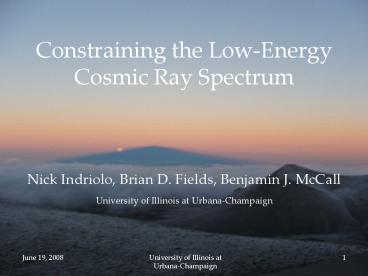Constraining the Low-Energy Cosmic Ray Spectrum PowerPoint PPT Presentation
Title: Constraining the Low-Energy Cosmic Ray Spectrum
1
Constraining the Low-Energy Cosmic Ray Spectrum
- Nick Indriolo, Brian D. Fields, Benjamin J. McCall
University of Illinois at Urbana-Champaign
2
Cosmic Ray Basics
- Charged particles (e-, e, p, a, etc.)
with high energy (103-1019 eV) - Galactic cosmic rays are primarily accelerated in
supernovae remnants
3
Background
- Cosmic rays have several impacts on the
interstellar medium, all of which produce some
observables - Ionization molecules
- CR H2 ? H2 e- CR
- H2 H2 ? H3 H
- Spallation light element isotopes
- p, a C, N, O ? 6Li, 7Li, 9Be, 10B, 11B
- Nuclear excitation gamma rays
- p, a C, O ? C, O ? ? (4.4, 6.13 MeV)
4
Motivations
- Many astrochemical processes depend on ionization
- Cosmic rays are the primary source of ionization
in cold interstellar clouds - Low-energy cosmic rays (2-10 MeV) are the most
efficient at ionization - The cosmic ray spectrum below 1 GeV cannot be
directly measured at Earth
5
Example Cosmic Ray Spectra
1 - Nath, B. B., Biermann, P. L. 1994, MNRAS,
267, 447 2 - Hayakawa,
S., Nishimura, S., Takayanagi, T. 1961, PASJ,
13, 184 3 - Valle, G., Ferrini, F., Galli,
D., Shore, S. N. 2002, ApJ, 566, 252
4 - Kneller, J. P., Phillips, J. R., Walker, T.
P. 2003, ApJ, 589, 217 5 - Spitzer,
L., Jr., Tomasko, M. G. 1968, ApJ, 152, 971
6 - this study
6
Motivations
- Recent results from H3 give an ionization rate
of ?2410-16 s-1 - Given a cosmic ray spectrum and cross section,
the ionization rate can be calculated
theoretically
Indriolo, N., Geballe, T. R., Oka, T., McCall,
B. J. 2007, ApJ, 671, 1736
7
Cross Sections
Bethe, H. 1933, Hdb. d Phys. (Berlin J.
Springer), 24, Pt. 1, 491 Read, S. M., Viola,
V. E. 1984, Atomic Data Nucl. Data, 31, 359
Meneguzzi, M. Reeves, H. 1975, AA, 40, 91
8
Leaky Box Model
9
Leaky Box Model
- Broken power law in momentum
- Produces an ionization rate of 110-17 s-1, much
lower than the value inferred from H3 - Try a spectrum with more flux at low energies by
changing power law index below 200 MeV
10
Matching Observations
- Float the spectral index to match inferred ?2
- Choose a low energy cutoff (2 MeV)
- We find a relationship of p-2.0 is required to
produce an ionization rate of 3.610-16 s-1 - This gives 8.610-17 s-1 assuming a 10 MeV cutoff
(dense cloud)
Cravens, T. E., Dalgarno, A. 1978, ApJ, 219, 750
11
Effects on Light Elements
Lemoine, M., Vangioni-Flam, E., Cassé, M.
1998, ApJ, 499, 735
12
Effects on Gamma Rays
- Interstellar gamma ray lines at 4.4 MeV 6.13
MeV have not been observed - We predict a diffuse Galactic flux of 610-8
cm-2 s-1 deg-2 for both lines - This is below the detection limit of current
gamma ray telescopes such as Integral
13
Energy Requirements
- We can also calculate the rate at which all of
the particles in our spectrum lose energy - The result is 0.151051 ergs century-1
- The standard supernova energy is 1051 ergs, and
the standard supernova rate is 3 per century in
the Galaxy, so this energy requirement is well
within the Galactic budget
14
Conclusions
- Leaky box propagated spectrum is unable to
account for ionization rate - Possible to generate an ionization rate of about
410-16 s-1 given the correct power law index
(p-2) at low energies - This spectrum is in rough agreement with light
element abundances, and is not inconsistent with
gamma ray observations - Required input energy is available from supernovae
15
Future Work
- Use more advanced cosmic ray models including
re-acceleration effects - Consider variation of the cosmic ray spectrum in
space and time - Continue observations to put better constraints
on the ionization rate in various environments
16
Acknowledgments

